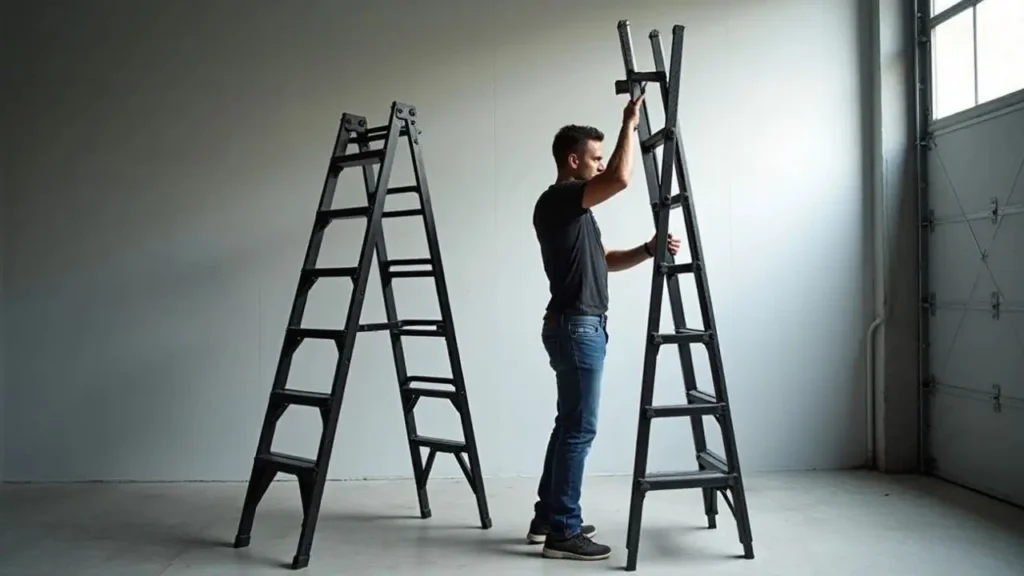Quick Summary: Carbon Fiber Ladders Tested: Half The Weight, Twice The Strength
- Content Type: Guide
- Last Updated: August 2, 2025
- Best For: Boat owners, military users, and contractors who need a portable, strong, and safe ladder for specialized tasks.
- What’s Great: Extremely lightweight, non-conductive for electrical work, and resistant to corrosion and extreme temperatures.
- What’s Not: The high initial cost makes them unsuitable for casual homeowners with a limited budget.
- Buy If: You prioritize a ladder's portability, strength, and safety for demanding or unique jobs.
- Avoid If: If you need a cheap Ladder just for small house works.
- Affiliate Link Present: Yes
Carbon fiber ladders are causing a shift in the way people view portable climbing tools. Picture a ladder so light it’s just a quarter of steel’s weight, yet it’s four times as strong. This isn’t just a future concept. It’s what carbon fiber tech is delivering right now.
When I grabbed a carbon fiber ladder that weighed 2.2 pounds, I doubted the claims about its performance. But watching it hold up to 220 pounds per step shifted my perspective. These carbon fiber step ladders come packed with some pretty standout features. They’re about 79 inches tall with a base 19 inches wide. The all-carbon fiber frame keeps the ladder lightweight at just 1kg—or 2.2 pounds—while every step can carry up to 99kg, which is about 218 pounds. Besides their strength and light design, these ladders are adaptable. You can mount them in different spots and store them , which makes them ideal to use in boats or cramped areas.
In this review, we will look at a variety of carbon fiber ladders available in 2025. We’ll test their performance in detail and help you figure out if spending your money on this sturdy and lightweight tool makes sense.
Disclaimer
Affiliate Disclaimer
I want to be 100% honest with you. Some links you see in my post are ‘affiliate links’. This just means if you click one of my links and then buy a tool, I get a very small money from the shop.
This does not cost you any extra money at all. The price is the same for you.
This small help lets me keep this blog alive and test more tools for you. Please know, I only link to tools I have used myself or received a verified review of the tool and believe are good. My words and my review are my own, nobody pays me to say nice things. Thank you for your support!
Image Information
All product images used in this post are provided by the author and claimed to be their own usage. According to the author, these images are either self-clicked, taken during hands-on testing, or screenshots captured for review purposes. If you believe any image violates your rights, please contact us for proper credit or removal.
Price & Stock Information
The product prices and availability mentioned in this post are accurate as of the time of publishing. However, prices may change on the seller’s website without notice. Please always check the latest price and stock status on the official product page before making a purchase decision.
Specs and Construction of Carbon Fiber Ladders
The design of carbon fiber ladders marks an impressive step forward in climbing tools. Manufacturers use strong carbon fiber materials with a patent-pending joint design. This combination gives the ladders great strength while keeping their weight very low.
The structure relies on ultra-high modulus carbon fiber tubes made through advanced axial fiber laying techniques. Many models are tested for durability under harsh conditions, from freezing -40°C to scorching +60°C.
Most models share these key specifications:
- Load capacity: Carbon fiber ladders can hold between 158 lbs (71 kg) and 350 lbs (158 kg).
- Weight: Each section weighs from 2.5 lbs (1.33 kg) to 5.3 lbs (2.4 kg).
- Compact storage: A 5-section ladder that stretches to 3.7 m (12 ft) collapses into small easy-to-move pieces.
The rungs have a textured surface that offers strong grip in different conditions. The material in these ladders, carbon fiber, does not conduct electricity, which provides safety when working near live wires.
Manufacturers use monocoque frames to strike the right mix of strength and weight. Each part is shaped as a single piece to cut down on weak spots and connections. This creates carbon fiber ladders with a signature high strength-to-weight ratio. They are about four times as stiff as fiberglass but much lighter to carry.
Performance Testing: Strength, Stability, and Durability
Tests show carbon fiber ladders are five times stronger than steel, yet they weigh just one-fourth as much. Load testing highlights their impressive strength, with each rung holding up to 99 kg (218 lbs) even though the whole ladder weighs 1 kg.
The impressive tensile strength of carbon fiber makes these ladders much more stable under shifting loads than ladders made from usual materials. Engineers use thorough tests to check how these ladders hold up, including stress from side deflection bending , and twisting forces.
Carbon fiber is also a safer option near electricity because it doesn’t carry electrical currents like aluminum does. Its resistance to corrosion makes it last longer in tough environments near salty sea areas where regular ladders degrade fast. However, while the carbon fibers stand up well against damage, the epoxy that holds them together can weaken with UV light leading to a yellowing effect over time.
Tests on durability show that carbon fiber ladders keep their strength intact even when temperatures swing between -40°C and +60°C. While they might cost more at first, their longer lifespan saves money over time since they require fewer repairs.
Carbon fiber frames perform about as well as steel ones, but they weigh up to 32% less. This gives these ladders a great strength-to-weight balance better than what aluminum or regular fiberglass models can achieve.
Buying Guide: Models Pricing, and Where to Look
When choosing carbon fiber ladders, plenty of options are available in the market. Step ladders dominate, but there are also extension, telescopic, and platform types. These ladders meet various needs, from routine home repairs to advanced military tasks.
Top ladder makers include Werner Co., Louisville Ladder Inc., Little Giant Ladder Systems, and Gorilla Ladders. For tactical operations, Armadillo Tactical Gear and Atlas Devices provide military-spec ladders. MATBOCK’s LIFT Ladder system offers a lightweight yet strong design weighing 4.97 pounds and holding up to 400 pounds.
Prices change a lot depending on the design and what the ladder is meant to do. Basic carbon fiber ladders often cost about $2,000. Armadillo Tactical sells more advanced models that range in price. A single-section ladder costs $2,950, while a 5-section version can go up to $7,230. To use on ships, Exit Carbon provides ladders starting at €2,545, with the most premium models costing as much as €31,390.
When choosing a carbon fiber ladder, you need to think about things like how much weight it can hold how easy it is to carry how sturdy it feels, and the overall design. Most can handle weights between 200 and 400 pounds even though they weigh about 2.1 to 2.5 kg. They cost more at first compared to regular ladders, but they last longer and work better so many people find them worth the money.
Conclusion
After a lot of testing, carbon fiber ladders match their big promises. These designs show just how lightweight yet strong they can be. I stopped doubting them when I saw a tiny 2.2-pound ladder hold more than 200 pounds on each rung without breaking a sweat.
Their lightness and strength are not the only things they get right. They are safer for anyone working near electricity because they don’t conduct. They also don’t rust, which makes them perfect to use near the ocean. On top of that, they take up very little space when stored solving space issues for people with cramped storage needs.
The starting price of $200 may seem expensive at first, but their lasting value shows when you look at how durable they are. Traditional ladders wear down fast in tough weather, but carbon fiber ladders hold up even when faced with extreme temperatures.
So, who are these ladders best for? They are a smart option to choose if you prioritize portability while keeping safety in mind. People like boat owners military users, or contractors with specialized tasks can benefit the most from using them. On the other hand casual homeowners could find the high cost hard to justify unless they have specific needs or limited storage space.
Carbon fiber ladders mark a big leap in climbing gear. These ladders are not for everyone since their high price keeps them out of reach for some, but they serve a specific purpose for people who need strength and lightweight tools. This might be the future of portable climbing gear—it just happens to weigh about a fourth of what normal ladders do.
Key Points
Carbon fiber ladders bring new advancements to climbing technology by offering incredible strength while staying lightweight. They push the limits of what portable ladders can do.
- Each rung on a carbon fiber ladder weighs 2.2 pounds and can hold up to 220 pounds providing four times the strength of steel while being much lighter.
- These ladders resist corrosion and do not conduct electricity, which makes them a great choice to use in marine settings or electrical tasks where standard ladders fall short.
- The price begins at about $200. With a solid, heavy-duty build, they’re made to operate in severe temperature ranges (-40°C to +60°C) make them worth it to users with specific needs.
- Ideal options exist for military personnel, contractors, and boat owners who want portability and safety. Casual homeowners though, might not see the value for the high price tag.
- Top brands like Werner Co., MATBOCK, and tactical specialists sell models like simple step ladders or more advanced telescopic designs.
Premium pricing makes carbon fiber ladders more popular for specific needs. Professionals needing strong, light, and secure climbing gear in tough situations find these ladders useful.
FAQs
- Q1. How much weight can carbon fiber ladders hold? Most carbon fiber ladders can carry between 200 and 400 pounds. Some versions can even take up to 220 pounds on a rung, but each ladder weighs just 2.2 pounds.
- Q2. Are carbon fiber ladders good for electrical jobs? Yes, they work well for electrical tasks. Their non-conductive material makes them a safer choice than standard metal ladders for working near electricity.
- Q3. How do carbon fiber ladders handle extreme heat and cold? Carbon fiber ladders stay strong and stable between -40°C and +60°C. This makes them tough and reliable in different kinds of weather.
- Q4. Why are carbon fiber ladders better than regular ones? Carbon fiber ladders weigh less, handle more weight, and do not rust as as regular ladders. Their excellent strength compared to their light weight makes them great to carry around and use in tough jobs.
- Q5. How much do carbon fiber ladders cost? Carbon fiber ladders cost at least $200 for simpler models. More advanced or custom ladders can range between $200 and upwards of $2,000, depending on their purpose and design.





